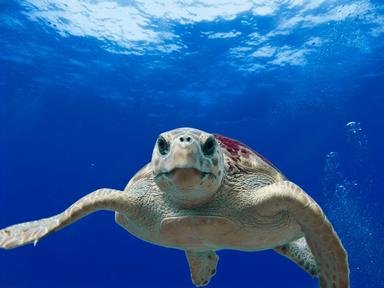Quiz Answer Key and Fun Facts
1. As a hatchling, you have just fought your way through a ping-pong ball sized egg. You notice you and the majority of your siblings from the clutch are males. Why did this happen?
2. Unfortunately, you and your newly born sea turtle hatchling siblings are up to 18 inches (45cm) deep in the sand at birth. How will you get out of this nest?
3. You've now reached the beach. You look for the evening's brightest horizon. That should be the sea. What could send you in the wrong direction?
4. As you fight your way toward the sea, you and the other hatchlings must watch out for predators such as martens and gulls. But, what man-made obstacles might also hinder your progress toward the sea?
5. As a hatchling, you have avoided the pitfalls of the beach and made it to the sea. The next three to seven years are termed by scientists as the "lost years." Where are you, as a young loggerhead turtle, likely to be found during these years?
6. You have now survived the loggerhead sea turtles' lost years. You are the size of a rugby ball. What animals are your two remaining threats?
7. Adult loggerhead turtles usually forage for food traveling between feeding and mating grounds throughout the year. What do adult loggerheads eat in their feeding grounds?
8. As an adult male loggerhead, how many times a year will you usually leave the water and return to the beach?
9. It's mating season. As a male loggerhead turtle you enter breeding grounds to mate with females. After you have mated with a female, where does she go to lay her clutch (group of eggs)?
10. What are the steps in the process of the female loggerhead turtle in nesting?
Source: Author
pericles34
This quiz was reviewed by FunTrivia editor
crisw before going online.
Any errors found in FunTrivia content are routinely corrected through our feedback system.

